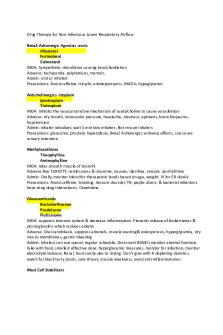Antilipemic Drugs - Med note PDF

| Title | Antilipemic Drugs - Med note |
|---|---|
| Author | Taviel Bartley |
| Course | Pharmacology For Nursing Practice |
| Institution | Chamberlain University |
| Pages | 4 |
| File Size | 323.5 KB |
| File Type | |
| Total Downloads | 89 |
| Total Views | 141 |
Summary
Med note...
Description
NR293 Pharmacology for Nursing Practice Pharmacology Notes: Drug Group Non-Pharmacology
Eat better Lose weight First-line drug therapy for hypercholesterolemia but it’s the last resort
Nursing Implications •
Before beginning therapy, obtain a thorough health and medication history.
•
Assess dietary patterns, exercise level, weight, height, vital signs, tobacco and alcohol use, and family history.
•
Assess for contraindications, conditions that require cautious use, and drug interactions.
•
Contraindications include biliary obstruction, liver dysfunction, and active liver disease.
•
Obtain baseline liver function studies.
•
Patients on long-term therapy may need supplemental fat-soluble vitamins (A, D, K).
•
Refer to guidelines regarding administration times and meals.
•
Atorvastatin (Lipitor) - Dosed once daily, usually with the evening meal or at bedtime to correlate with diurnal rhythm
•
Counsel patient concerning diet and nutrition on an ongoing basis.
•
Instruct patient on proper procedure for taking the medications.
•
Powder forms must be taken with a liquid, mixed thoroughly but not stirred, and never taken dry.
•
Other medications should be taken 1 hour before or 4 to 6 hours after meals to avoid interference with absorption.
•
To minimize adverse effects of niacin, start on low initial dose and gradually increase it, and take with meals.
•
Small doses of aspirin or NSAIDs may be taken 30 minutes before niacin to minimize cutaneous flushing.
•
Provide teaching regarding use of NSAIDs and aspirin.
•
Inform patients that these drugs may take several weeks to show effectiveness.
•
Instruct patients to report persistent GI upset, constipation, abnormal or unusual bleeding, and yellow discoloration of the skin.
NR293 Pharmacology for Nursing Practice •
Instruct patients to immediately report any signs of toxicity, including muscle soreness or changes in urine color.
•
Monitor for adverse effects, including increased liver enzyme studies.
•
Monitor for therapeutic effects:
•
Reduced cholesterol and triglyceride levels
Class Antilipemic Statins “statin”
Antilipemic
Examples
MOA
Indications
Lovastatin Pravastatin Simvastatin Atorvastatin Rosuvastatin
Reduces cholesterol
Cholestyramine
Reduce cholesterol
Bile Acid
Reduce cholesterol
Adverse Effects Rash HA Muscle pain (rhabdomyolysis) Hepatoxicity
Heartburn Nausea Belching Bloating Constipation
Flushing (caused
Contraindications Hypersensitivity Interactions: Grapefruit juice
Interactions: All drugs must be taken at least 1 hour before or 4 to 6 hours after the administration of bile acid sequestrants. High doses of a bile acid ↓ the absorption of fatsoluble vitamins (ADEK)
Nursing Implications Monitor renal function Monitor cholesterol
↑ fiber in diet Take Metamucil (Mix well with 8 oz of H2O), and ↑ fluid intake. Substitute supplement vitamins
NR293 Pharmacology for Nursing Practice Niacin B3 (Nicotinic Acid)
Fibric Acid Derivatives “fib”
Class
Gemfibrozil Fenofibrate
Examples
Treatment of hyperlipidemias
MOA
by histamine release -itching) Pruritus GI distress -you can give NSAID drugs for the itching. Abdominal discomfort N/D Blurred vision HA ↑ risk of gallstones Prolonged prothrombin time
Pharmacology Notes: Drug Group Indications Adverse Effects
Hypersensitivity Liver or kidney disease Cirrhosis Gallbladder disease Interactions Statins Oral anticoagulants
Contraindications
Nursing Implications
NR293 Pharmacology for Nursing Practice...
Similar Free PDFs

Antilipemic Drugs - Med note
- 4 Pages

Herpes drugs, anti cancer drugs
- 6 Pages

Hemostasis drugs
- 5 Pages

Psychotomimetic drugs
- 7 Pages

Controlled Drugs
- 25 Pages

Respirotory Drugs
- 3 Pages

Dopaminergic Drugs
- 2 Pages

Drugs-immmunity
- 19 Pages

Drugs Pregnancy
- 9 Pages

Gastrointestinal drugs
- 3 Pages

Psych Drugs
- 19 Pages

Antiepileptic drugs
- 5 Pages
Popular Institutions
- Tinajero National High School - Annex
- Politeknik Caltex Riau
- Yokohama City University
- SGT University
- University of Al-Qadisiyah
- Divine Word College of Vigan
- Techniek College Rotterdam
- Universidade de Santiago
- Universiti Teknologi MARA Cawangan Johor Kampus Pasir Gudang
- Poltekkes Kemenkes Yogyakarta
- Baguio City National High School
- Colegio san marcos
- preparatoria uno
- Centro de Bachillerato Tecnológico Industrial y de Servicios No. 107
- Dalian Maritime University
- Quang Trung Secondary School
- Colegio Tecnológico en Informática
- Corporación Regional de Educación Superior
- Grupo CEDVA
- Dar Al Uloom University
- Centro de Estudios Preuniversitarios de la Universidad Nacional de Ingeniería
- 上智大学
- Aakash International School, Nuna Majara
- San Felipe Neri Catholic School
- Kang Chiao International School - New Taipei City
- Misamis Occidental National High School
- Institución Educativa Escuela Normal Juan Ladrilleros
- Kolehiyo ng Pantukan
- Batanes State College
- Instituto Continental
- Sekolah Menengah Kejuruan Kesehatan Kaltara (Tarakan)
- Colegio de La Inmaculada Concepcion - Cebu



